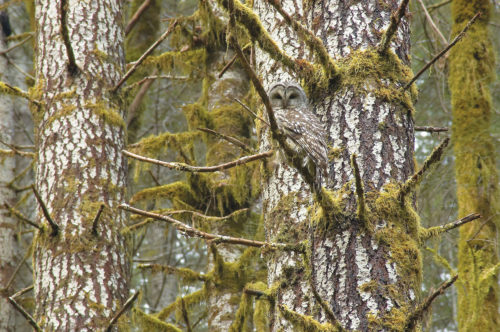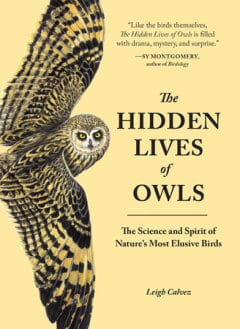Rarely Spotted : Northern Spotted Owls

Guest post by Leigh Calvez, author of the new book The Secret Lives of Owls. Join us Thursday, Sept 22, at Village Books for a free reading from this great new title from Sasquatch Books, the first event in our Fall 2016 Nature of Writing Speaker Series in Bellingham.
Perhaps the most iconic of all owls in the Pacific Northwest is the Northern Spotted Owl (Strix occidentalis). I was excited to look for these owls in the wild, in the ancient trees where they live, before they disappear altogether. Sighting one seemed to me to be as epic, and just as improbable, as sighting a unicorn. Yet from all I’d heard from the biologists called “hooters”—for the hooting call that they make either electronically or with their own voices to determine if Spotted Owls are nesting in the area—these owls were still out there. Still, even the experts were finding only one or maybe two nests in their survey areas each year. Tracking them would be more of an adventure than I could yet imagine.
Through the grapevine of owl biologists, I contacted Stan Sovern, a Forest Service biologist who has been monitoring the Spotted Owl population in Washington State, both on the Olympic Peninsula and in Central Washington, for the past twenty-eight years. He invited me out for an afternoon check of one active nest site. I met Stan and Margy Taylor, another longtime Forest Service hooter, at the Cle Elum Ranger Station. Then we drove east along I-90 to the forest edge, where the habitat abruptly turns to shrub-steppe, as if a line had been drawn through the state.
Just before we took the Taneum Creek exit to the interstate, I could see fields full of tall windmills turning in the breeze blowing down from the eastern Cascade slopes. There are spotted owls here? I wondered.
We then turned and headed west into some of the last remaining old-growth forest in Central Washington. It was here that we met William Meyer, a biologist from the Washington Department of Fish and Wildlife, who knew Margy from the days they had counted Spotted Owls together on the Olympic Peninsula. He now specializes in restoring beavers—once an integral part of the landscape—to their natural habitat and reclaiming watersheds that have dried up since beavers were removed from the land.
We wound around on back roads and dirt Forest Service roads. I was properly sworn to secrecy about the exact location of the nest and instructed not to return on my own. No problem there, I thought. I couldn’t find my way back if I tried. We hiked along a recreational trail that had been heavily used by motor- bikes and ATVs. I wondered how the elusive Spotted Owl lived among all this activity. Little did I know we were still far from the nest site. We crossed a little bridge and then headed o -trail, straight up a steep slope. It was slow going. Hiking uphill would not have been a problem for me if it hadn’t been for climbing over all the downed dead trees through tangles of short shrubs.
Spotted Owls are fairly particular when it comes to choosing territory. While other owls easily use a variety of open fields or forest edges, Spotted Owls prefer dense old-growth forests with several very specific characteristics present. e more of these features a forest can provide, the better. A closed canopy for protection from avian predators like Northern Goshawks and Great Horned Owls is highly valued. Standing dead trees, called “snags,” provide homes for their favorite prey, flying squirrels, and dead decaying logs provide great habitat for the squirrels’ food. Different aged trees and shrubs, called a “multilayered canopy,” and dwarf mistletoe infestations provide suitable Spotted Owl nesting habitat.
Once Spotted Owls choose a territory, unless some major event occurs, such as a re or clear-cutting or the death of a mate, they tend to stay on the same land for the rest of their lives. I once heard a biologist telling the story of a pair of Spotted Owls sitting in the last remaining tree in the middle of a clear-cut, as if wondering what had happened to their neighborhood.
In the winter months, they do not migrate as some owls are known to do. Instead, they expand their home range as food resources are depleted, while their core habitat remains the same. Because they live so far from the beaten path, humans rarely see Spotted Owls, as I was learning.
Amazed, I watched the proceedings with fascination. Kari grabbed her notebook and, like a Jane Goodall of owls, took notes on each behavior she witnessed over the next two hours that we watched this wild Spotted family.
About half an hour into our observation, we watched as the babies flew after their mother to a branch a bit farther up the hill. They were now good, strong fliers, and Kari could count them as edged.
Later, one chick held a mouse in its beak as if it was thinking of swallowing the mouse backward instead of the usual way— head first. Mom then tried to take the mouse from the chick. But the baby held the mouse tightly, refusing to give up its prize. e chick then proceeded to choke it down tail first, the mouse’s beady black eyes and whiskers disappearing last down the baby’s throat.
The other baby, now sitting in what looked like a cache tree, where the father stored extra food for later, seemed to find the remains of a flying squirrel, which Kari managed to identify by the shape and size of its tail just before the baby swallowed the meal.
Then the father flew to within ten feet of us, sat on a branch, and peered at us through the notch of a tree. I admired his dark- brown feathers decorated with white spots and his kind, dark eyes. Although I knew this medium-size owl was an efficient predator, in this moment he seemed more like a longtime friend.
I tried to take in all the sounds of the owl family and the deep, green scent of the forest so I would remember this exquisite afternoon. I’d had a rare glimpse into the life of a wild Spotted Owl family. I felt full and grateful for the experience.
“Sometimes I’m walking along in a zone or just trying to keep myself alive going down the mountain and I hear an owl I wasn’t expecting,” Kari said as we made our way back down the mountain. “That’s where the magic is. It happens once or twice a sea- son. That’s what keeps me going.”
We crossed the stream and left the forest, going back to our lives, leaving the Spotted Owls in peace to live their own lives.

Copyright 2016 by Leigh Calvez. All rights reserved. Excerpted from The Hidden Lives of Owls by permission of Sasquatch Books.

